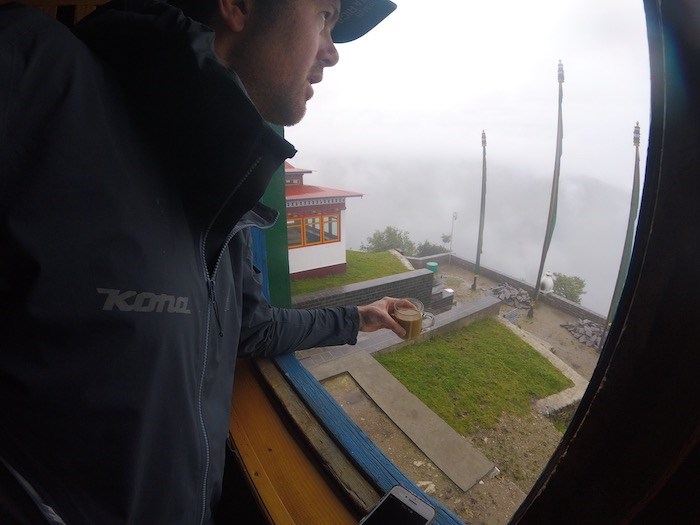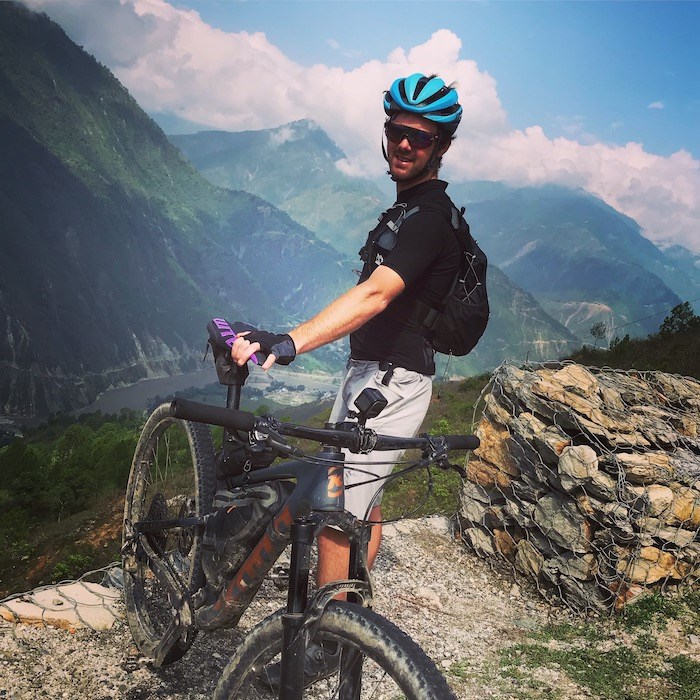
Background:
1 - Jasper champion cyclist stuck in Nepal as country locks down due to COVID-19
2 - WallaceÔÇÖs World: Champion cyclist Cory gives an update from Nepal
Cory Wallace |┬á Special to the 51░Á═°
Lockdown in Nepal turned into a bit of an adventure as I took off deeper into the mountains back in May to live at the Chiwong monastery, about 50 kilometres from Mount Everest.
The situation I had been living in was turning sour, and no hotels or guesthouses in the region were taking anyone in due to the coronavirus.
When our neighbouring Nepali family found out I was becoming homeless, they invited me to live with them. They already had 10 to 15 people in a pretty small house so it wasnÔÇÖt ideal to cram in there, and unable to head back to Kathmandu without proof of a flight out I was in a tricky situation.
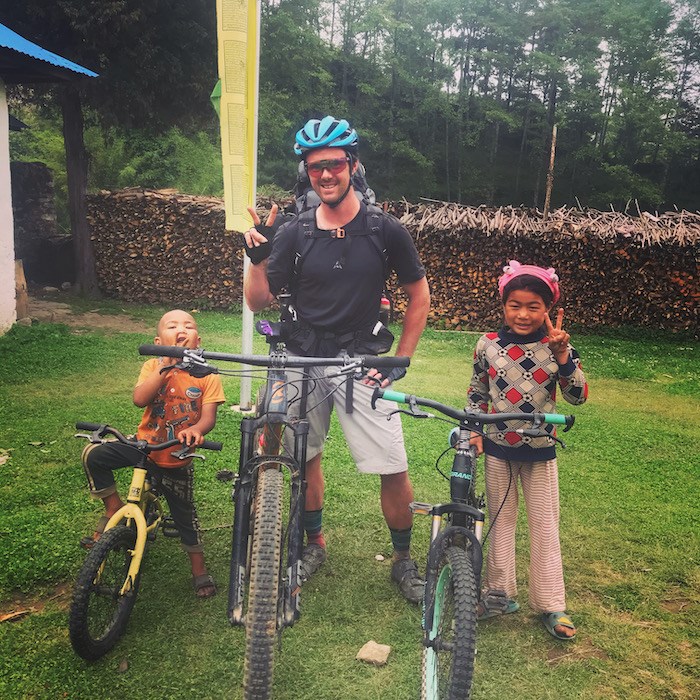
Having met the Head Lama a few times on bike rides past the monastery, it became apparent they would be happy to have me up there during lockdown. Having been in the mountains since February, well before lockdown occurred, I had been in isolation for months, and thus took up the offer to go live with the monks.
Moving in with monks
It was weird not knowing what I was getting myself into, but the other option was to go find a cave somewhere to live in. Leaving my extra luggage with our Nepali neighbours, I loaded my backpack with necessities, hopped on my Kona and took off for the unknown.
It was a short but rough 20 kilometre bike ride, gaining 600 vertical metres, climbing up a steep Himalayan road to the monastery. I was excited, but at the same time a bit unsure how I would be welcomed as an outsider during a global pandemic.
The monastery is perched on a cliff at 2,950 metres, surrounded by jungle, overlooking the Solukhumbu valley. Its location is amazing, and the residents include 35 monks of all ages, most of them young kids between the ages of 8 to 15.
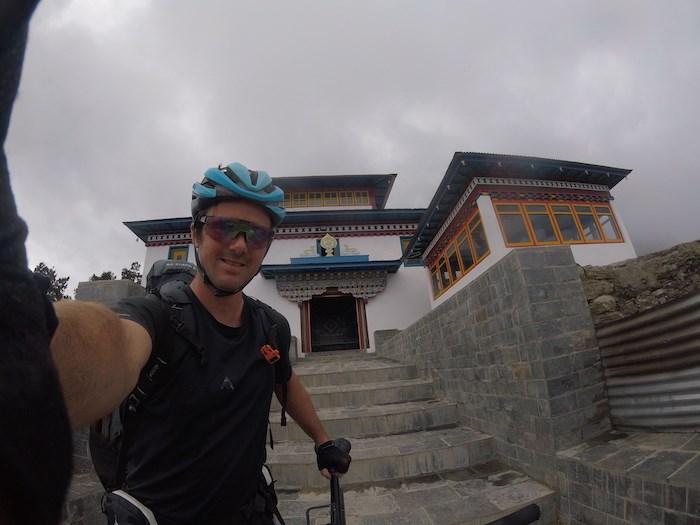
They had been taken in from poor families in the surrounding villages and given a chance at a great life full of education, food and a community to live in. Right from the minute I arrived they treated me like a brother, offering a Dhal Bhat for dinner and giving me a room with an epic view over the valley, lying over half a vertical kilometre below.
To be living with a bunch of monks in this setting was something out of a storybook.
The first few nights were a bit rough as they had a three-day puja - a worship ritual to offer prayer and devotion to a belief system - going on, which began with banging on a gong and ringing a giant bell at 3 a.m., which was unfortunately right above my room.
Thankfully these 3 a.m. mornings ended after a few days, and they went back to their normal programming of 6 a.m. pujas. During this time I would practice meditation, to the tune of their puja in the background.
Settling in
The environment living in the monastery was one of the most positive experiences of my life. The monks have a great community, looking after each other, enjoying life, and radiating positive energy all around them.
They would go about their days of pujas, school, and work around the monastery, while I would go out training in the mornings, building some trails, and then would meet them for meals and to visit. The lifestyle was great, and I now had a new home as the monks became my lockdown brothers.
The monks live much busier lives than I imagined, pretty much busy from 5 a.m. to evening, with a few breaks for food and rest in there. On Fridays they have half the day off, and then Saturdays they have completely off. On Saturdays they always had a mission.
One day we took off to the jungle for a hike, little did I know we were off to find new flag poles for their prayer flags. It took 12 of us most the morning to haul back a couple huge logs. Once we arrived at the top of the hill above the monastery they fired them down the slippery slope into the abyss.
For riding, the monastery was the perfect basecamp. There were three trails heading off the mountain from our location near 3,000 metres. One was ideal for riding, we had ridden it many times before as it switchbacked down the cliff in front of the residence.
There was one, the old access, which now had the monastery road overlapping it, and then another one, fairly overgrown, as it traversed the mountainside to join onto the Ratnange Mountain. Ratnange is full of trails so this link was pretty key, thus I spent a day cleaning it out, and soon had my trail from the monastery linking to the epicentre of the Solukhumbu riding area.
It turned into a great lifestyle of training, living and experiencing life at a Buddhist resort in the Himalayas. I fit in pretty well there, made me think IÔÇÖm basically just a bike riding monk.
Giving back
Wanting to give back to the monks for giving a stranded traveller a home during the never ending Nepali lockdown, I started thinking of different fundraisers to do.
With no racing on the schedule, everyone seemed to be doing Everesting attempts around the world. The monastery access road was rough and steep at 13 per cent gradient. It was pretty ideal for an Everesting at 2.8 kilometres, 366 metre vertical gain per lap.
Getting special permission from the Solukhumbu police to do the ride during lockdown, I set off at 5 a.m. on June 10 for one of the hardest rides in recent memory. The best part was watching the reaction of the monks, and the workers on the nearby Stupa (a Stupa is an important form of Buddhist architecture which contains relics and is used as a place for meditation), as I repeated the climb 25 times, over the course of 18 hours.
IÔÇÖm sure they thought I had lost my mind, the monks could see some suffering was going on so they brought out some hot food to keep me going. Raising over $6,000 CAD was a big bonus. After this I figured it was time to try to get back to Kathmandu and then onwards to Canada if possible.
Leaving the monastery
It was tough leaving the monastery in mid June, but I had been given special permission from the government office and the local police to ride my bike back to Kathmandu.
Requesting a permit, they said there was no permit for cycling and that if I got into any trouble just call the head of police in the Solu and he would get me out of it. Sounded like a plan. Heading out on June 16, I first gathered my luggage from Phaplu, organized transport to Kathmandu for it, then took off to Pattale, a small village on top of a mountain 40 kilometres away.
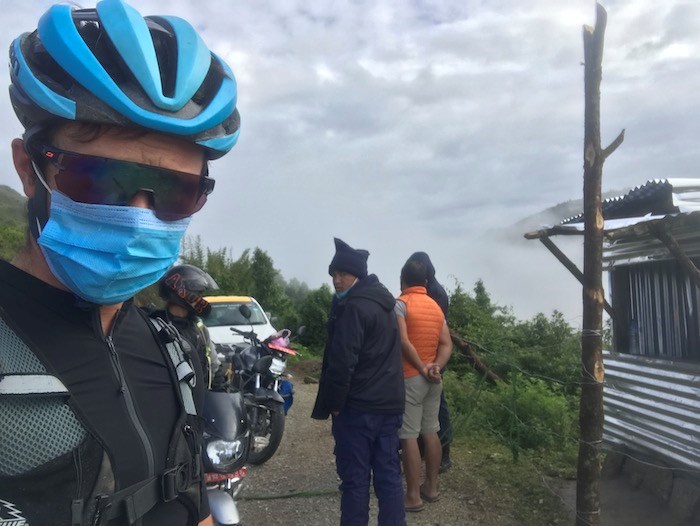
Here the police had organized a homestay. Unfortunately I got caught in a huge rainstorm and showed up drenched, well after dark. Following a tasty Dhal Bhat and short rest I was off the next morning at 6 a.m. as the mountainous 240 kilometres ride to Kathmandu was going to be a big day and take 12 to 14 hours if all went smoothly.
Hitting the first checkpoint 30 minutes into the ride, my aspirations were dashed as I was stopped along with 30 other people. Calling the police in Solu, they talked to the checkpoint police, but I was told without a pass there was no way to get by.
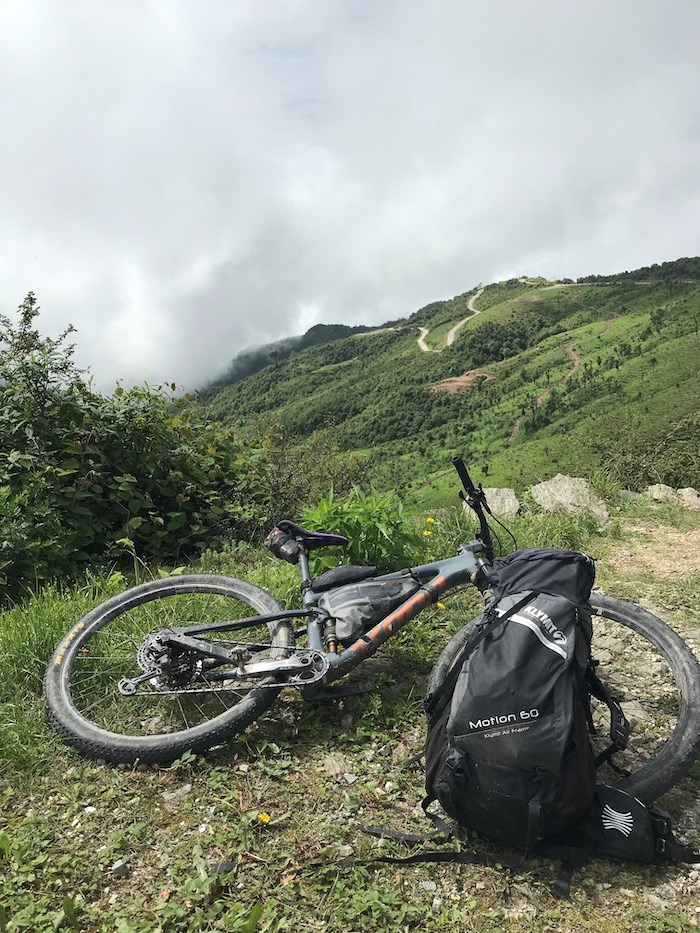
Thus, I turned around to head back and soon saw the truck which had my luggage on it. Pulling a U-turn I chased them down, yelling pretty loudly. Thankfully they heard me and pulled over.
Here, I sorted through my three bags on the side of the road, gathering basic supplies, loading my 60 litre Klymit backpack for another stint at the monastery. After nearly four hours I arrived back at the monastery. The monks were pretty shocked to see me but also seemed quite happy. It was disappointing to be banned from Kathmandu, but heading back to the monastery life felt like a homecoming.
Trying again
Another week in the Himalayas was great, although the monsoon rains were turning the riding more into mud sliding, and I had now missed a possible flight back to Canada. Heading back to the government office, I requested a proper pass for the next attempt for Kathmandu and finally received the documents needed.
Driving could have been an option, but the thought of spending 12 hours in a jeep, with likely six to eight others, who would surely not be wearing masks, and likely coughing, didnÔÇÖt seem smart given the COVID situation. Besides the fact the winding rough roads in Nepal are far more enjoyable on a bike then in a vehicle.
On June 24 I set off for Kathmandu again, first organizing my luggage transport in Phaplu. Organizing the luggage transport was difficult this time as the jeep I used for the trip before was refusing to take my stuff again. I was confused so had my girlfriend call them and she found out they thought I was a sketchy guy, and likely transporting drugs because when I sorted through my bags on the side of the road, they saw my bags of white protein powder and chia seeds, thinking it was drugs. What to do? She got it sorted and thus I headed off to Pattale for the night.
The next morning I left at 6 a.m., arriving at the first checkpoint, holding my breath as the police checked my permit. They stamped it, and waved me through. ÔÇśYahoo!ÔÇÖ I thought, one checkpoint down, still seven to eight to go, but it was a good start.
A tough journey
Next up was a mammoth descent from 3,000 metres down to the valley below at 300 metres. I had been worried about rain on this ride, but instead it was a sunny day, the first one in over two months. This was unfortunate as the heat down in the valley was over 40 degrees celsius. Having lived in the cool temperatures of the Himalayas for the past four months, my body was not ready for this.
Over the course of the next five hours my body slowly unraveled. My buddy Roan was riding out from Kathmandu to guide me through the checkpoints for the last 100 kilometres. By the time I reached him, my body was in a full meltdown. He pulled me along for another 50 kilometres, with a couple stops to dunk my head in water, but it was too late, my system was shutting down for the day.
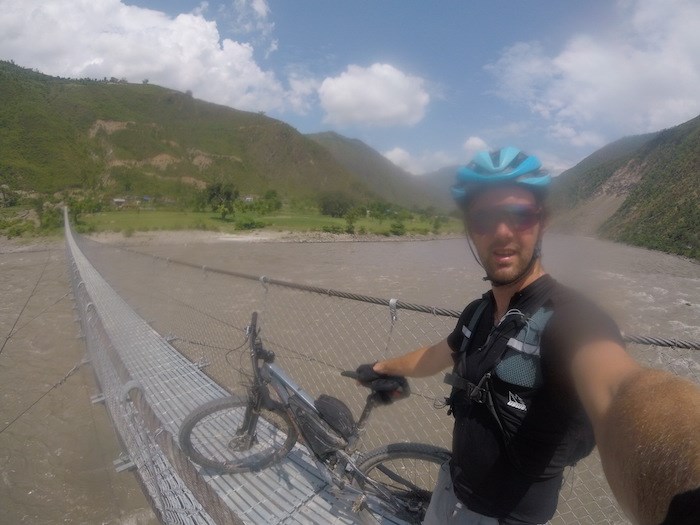
Arriving in Bhakunde Besi, 50 kilometres short of Kathmandu, at nightfall, we decided we best call it a night if possible. The problem was that it was lockdown and all the hotels were closed. Even if they were open weÔÇÖd likely not be invited as travellers during this sketchy time.
To our luck, we had noticed a sign for Katumba Resort a few kilometres back. We thought weÔÇÖd give it a shot so we asked some locals for directions and rode a couple kilometres out of town to find the shutdown resort.
The owner was out watering his plants, so Roan got his attention and told him our situation. Surprisingly, the guy was stoked to see us and opened up the resort for the night. This was a lifesaver as I was not looking forward to riding another 50 kilometres to Kathmandu through the night. With another two checkpoints to go, it could take hours if they decided to stop us.
Up to this point the checkpoints had been a breeze, especially after Roan had met me. Every checkpoint he would just start yelling some Nepali words and the police would wave us through.
Katumba resort treated us great, feeding us Chicken Dhal Bhats, giving us a place to rest for the night, and in the morning we took off for Kathmandu.
Arriving in the city
It was a short three-hour ride to Kathmandu, although the sky opened up and we got drenched, and amusingly a bit chilled. Where was this weather the day before?
Getting back to Kathmandu was a shock to my system after four months of mountain life. Being in lockdown I barely recognized the usually chaotic city. The traffic was down to 20 per cent levels, there was little pollution and most stores were shuttered.
Roan helped me grab my luggage, and off I went to find my new home, Anna LisaÔÇÖs condo. She had been evacuated to the UK a few months back due to the pandemic, and had generously offered her place until I could find a flight back to Canada.
I figured IÔÇÖd be in Kathmandu for a week and could find a flight out within that time. IÔÇÖve now been here over a month. My goal had been to avoid supporting the charter flights as they were being operated by travel agencies trying to make a fortune off other people's unfortunate situations due to the virus. The government had set a cap for these flights, but no one was following it. Canada had one repatriation flight back in April, but it was close to $4,000 CAD back to Vancouver. Prices were now down to $2,100 to 2,600 to Toronto.
Flighty flights
Luckily my friend Snowmonkey helped me find a bit of a better deal through a friend. I am not sure what happened but I subsequently ran into a natural hat trick of cancelled flights.
The first one, I think there weren't enough passengers so it didnÔÇÖt go. The second one they told me was cancelled and didnÔÇÖt go, but later I found out through calling Turkish Airlines that they did fly that day.
The problem with these flights is that there are three to four middlemen grabbing money, and for some reason they canned my ticket, possibly because they sold a ticket at a higher price last minute then cancelled the cheaper ones. What to do?
The third flight I booked was apparently 100 per cent guaranteed to go on July 21, but the government decided to ground all charter flights the day before this one left. They apparently did this as the charter companies had been ripping a lot of people off, and disobeying the governments cap on fares, thus they just stopped everything.
It was time they did this but it has left a few of us stranded again. This coincided with them lifting the countrywide lockdown which was a surprise as previously they had a five step plan to get out of lockdown, and we were still on step one.
Now the struggle is to get my money back from the travel agency and every day they have new excuses. Nearly three weeks after paying them nearly $2,000 CAD in cash, I have just over half back. Sketchy business.
At this point the government claims the airport will open August 17. This seems like the next chance out. The government has changed the opening date for the airport every two weeks since March so itÔÇÖs anyone's guess for what might happen. Rumour has it this August 17 date might actually stick. Throughout the COVID-19 pandemic, the Nepali government seems to be following whatever India does, and since India started flying international flights again, it is a good sign for Nepal. IÔÇÖll keep my fingers crossed.
Reflections
What has been awesome is the riding in Kathmandu over the past month. With little traffic or pollution it has opened up one of the best cycling cities in the world for us bikers.
Kathmandu has a pleasant climate being set at 1,300 metres. Surrounded 360 degrees by mountains, there are endless tracks and trails to explore.
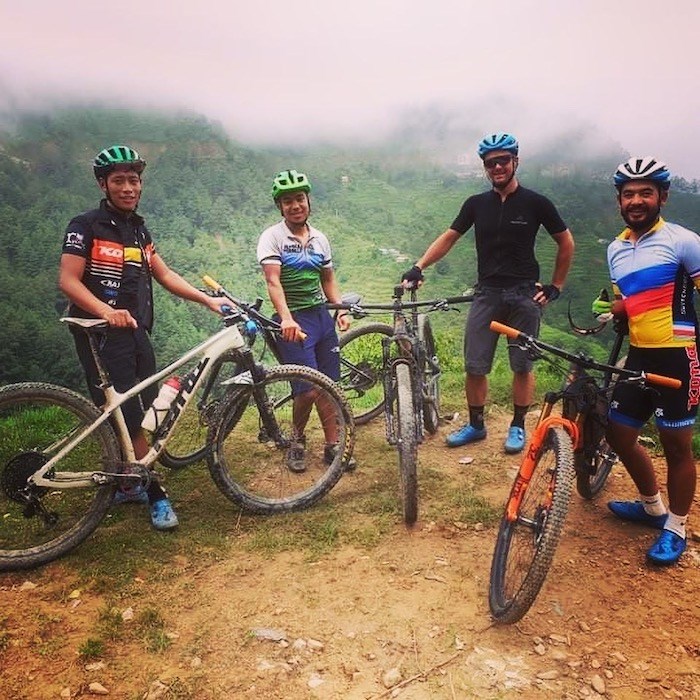
For a marathon rider it doesnÔÇÖt get any better. I had always dreamed of being in Kathmandu without pollution or traffic and all it took was a global pandemic to do so.
Now that the lockdown has been abolished overnight, the city is unfortunately pretty much back to normal. Pollution is down thanks to the monsoon rains, and the tourist hub of Thamel is empty.
In a few days the tourist activities such as trekking and mountaineering will apparently resume as the country is trying to gear up for the autumn tourism season. It could be pretty cool being in the mountains, as it will surely be a very quiet tourist season.
The only problem is that COVID-19 isnÔÇÖt controlled here and the possibility of another outbreak is real. With the government's trigger finger ready to shut down the airport at any moment, any trip to Nepal, or probably any place in the world right now is like opening a Kinder Surprise.
ItÔÇÖs really a tough situation to be in as Nepal depends so much on tourism dollars to keep the country going.
For some miraculous reason Nepal has only reported 45 COVID-19 deaths so in comparison to other problems such as hunger, poverty, landslides etc, it is still a relatively minor problem outside of the economic hit. It must be all the turmeric, garlic and ginger the locals are eating.
Looking ahead
What to do now? I had a summer planned out in Canada with some adventures after quarantine, but it looks like I will be absent for a while longer.
2020 has been a gong show thus far, the past four months probably warrants a book. I canÔÇÖt help but think back to the water pipe that took me out on a bike ride back in February and changed the course of my life with a dislocated shoulder. ItÔÇÖs still unfolding so I donÔÇÖt know if I should thank that water pipe or not, but up to now IÔÇÖm grateful for the experiences since then.
Canadian soil will just feel that much better every day longer IÔÇÖm out riding this COVID-19 wave. For now IÔÇÖm resting for a few days as I rode my bike pretty hard the past three weeks, always thinking my time in Nepal was limited and trying to make the most of it.
WeÔÇÖve now had three going away parties, three epic ÔÇťlast dayÔÇŁ rides, and IÔÇÖve packed and unpacked my bags numerous times. What to do but to continue rolling with it?
Over and out.

